- 9 Minutes to read
- Print
- DarkLight
- PDF
Reports Home Page
- 9 Minutes to read
- Print
- DarkLight
- PDF
To open any Dynamic Report or reports-related artifacts such as Report Sets, Report Collections, and Documents, click Reports from the Planful application's left panel to access the Reports home page. The home page displays the list of all reporting artifacts that you have permission to access and is equipped with multiple capabilities that allow you to manage and work with your reports efficiently.
Apart from accessing the existing reports, you can do the following on the Reports home page:
- Create new reports
- Refresh the home page
- Mark the important or frequently accessed reports as your favorite reports
- View recently accessed reports
- Use the Search feature to open any existing report quickly
Click on each tab below to find more details:
You can perform the following actions on the Reports home page:
Refresh - Click this icon to refresh the page.
New- Select this icon to add one of the following:
.png)
Folder - Select this to add a folder for storing reporting artifacts. Enter the Folder Code, Folder Name and select the Folder Location from the dropdown. Click Ok.
Report Set - Select this to create a Report Set, a flexible reporting tool that can be used on Dynamic Report's Row or Column axis.
Select a Report Set Type from the dropdown. Enter the value for Code, Name, Reporting Area, and Dimensions. Select a Folder location where you want to add the report set. Click Save. For more information on adding Report Set, click here.- Report Collection - Select this to add a collection of Dynamic Reports. For more information on Report Collection, click here.

- Document - Select this to load a document. Enter the Document Code, Document Name, and Upload Document using the Browse option.
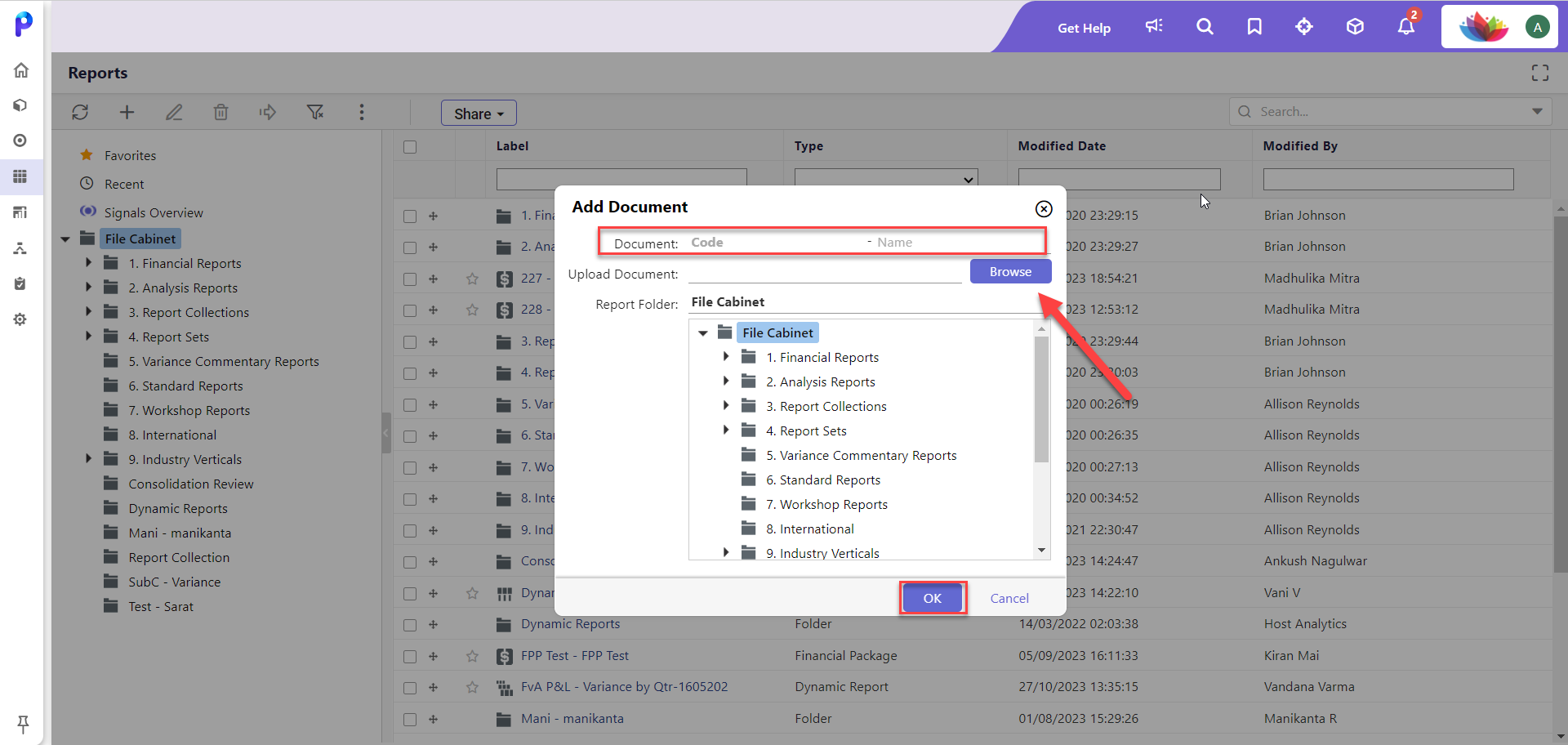
- Financial Package - Select this to create a Financial Package Publisher report. Enter the values in the Details and Content section of report properties and click Save. For more information on the Financial Package, click here.

- Dynamic Report - Select this to add a Dynamic Report. You can use a Dynamic Report to create queries on the go along with structured financial reports, which utilize reusable Report Sets. Select a Reporting Area from the drop-down and click OK. For more information on Dynamic Report, click here.
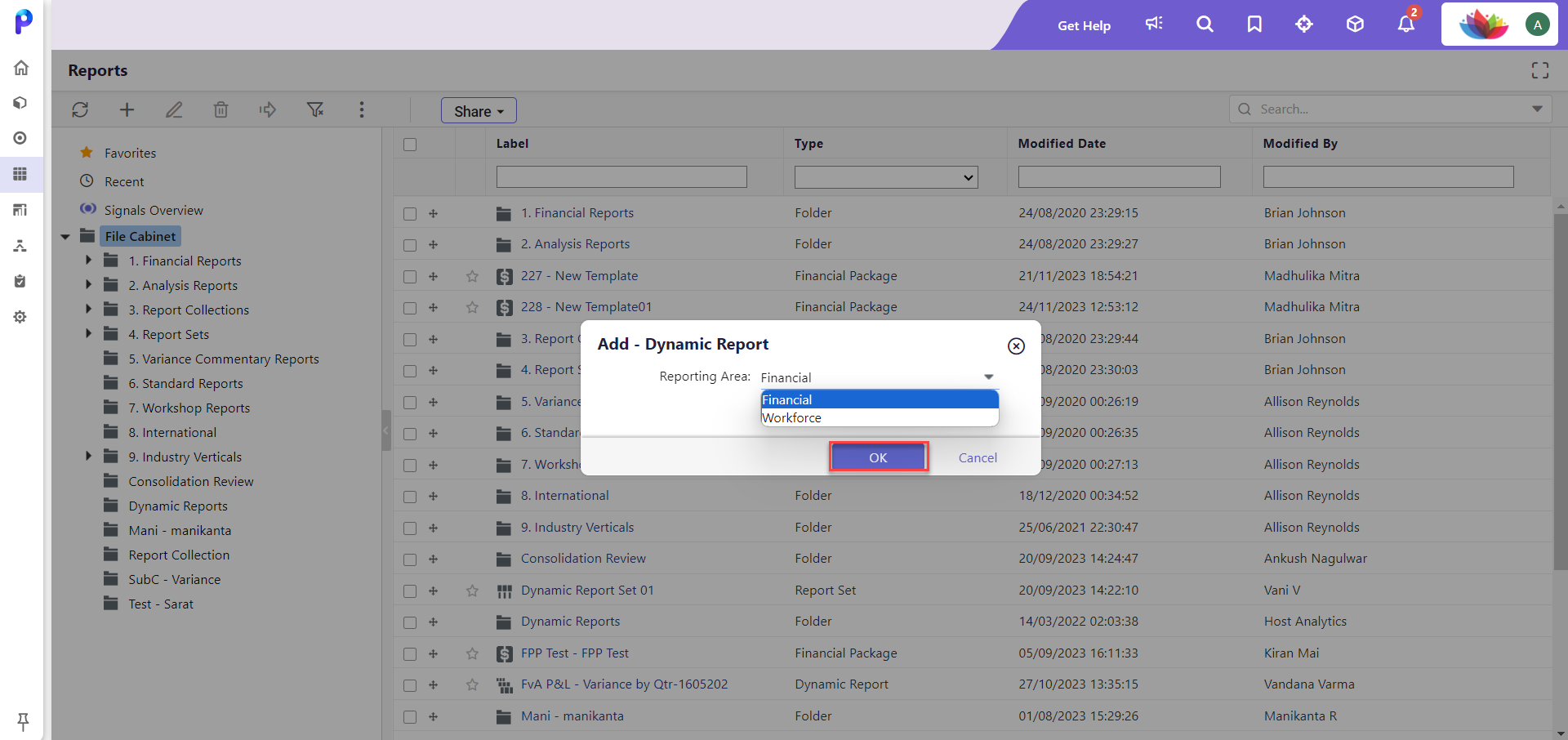
Edit - Select this icon to edit a folder.
Delete - Select this icon to delete the selected reports.
Run - Select this icon to run the selected Dynamic Report or Report Collection.
Apply Filter - Select this to apply the filter on the grid.
You can view the following options under the More list box based on your security settings:
Copy
You can use this option to duplicate an existing Financial Package, Dynamic Report, Report Collection, Snapshot, Report Set, or Document. To learn more about Copy, click here. Perform the following steps to copy any report artifact:
- Select the required artifact from the File Cabinet page.
- From the More Options list box, click Copy. The Copy Report is displayed.
- Enter the Report Code and Name in the respective fields. The selected report code is displayed by default in the Code field.
- From the pane below the Location field, select the required location.
- Click OK to save the artifact.
Rename
- Select the required report from the File Cabinet page.
- From the More Options list box, click Rename.
- Modify the Code and Name in the respective fields. Click OK.

Setup
You can use the Setup option to view the structure of a Financial Package, Dynamic Report, and Report Collection. You can do the following to view the structure:
- Select the required report from the File Cabinet page.
- From the More Options list box, click Setup.
Depending on the type of report you select, you can perform various activities on their respective Setup pages. Refer to the respective articles to know more about them.
Add to Favorite or Remove from Favorite
- Select the required report from the File Cabinet page.
- From the More Options list box, click Add To Favorite.
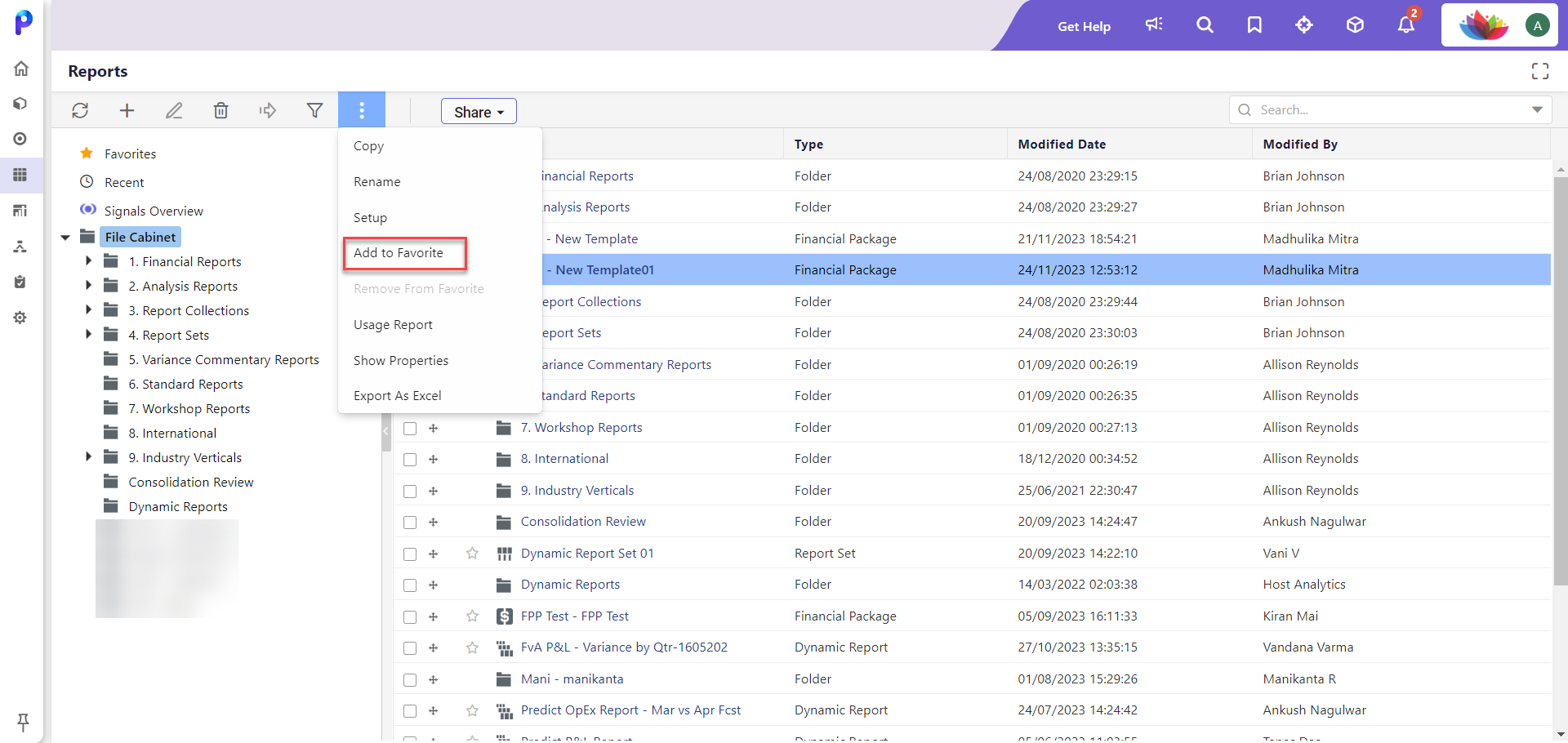
- The selected report is added to the Favorites tab and a star icon is highlighted against the selected report.

To learn more about Favorites, click here.Note:The Add/ Remove Favorite functionality does not apply to user groups.
Usage Reoprt
Usage Report- The Usage Report provides information about the segment member such as if the segment member is used in a budget entity, if the segment member has data, and if the segment member is used in template defaults.- Select the required report from the File Cabinet page.
- From the More Options list box, click Usage Report.
- Toggle to the Usage Report tab and see Label, Type, and Path where the member is used.
.png)
You can also perform actions like Refresh, Export, and Apply Filter on the Usage Report.
- Refresh - Click the Refresh icon to update the report.
- Export - Click the Export icon to export the selected report.
- Apply Filter - Click the Apply Filter icon to filter the report.
Show/Hide Properties
- Select the required report from the File Cabinet page.
- From the More Options list box, click Show Properties. The Properties tab is displayed.
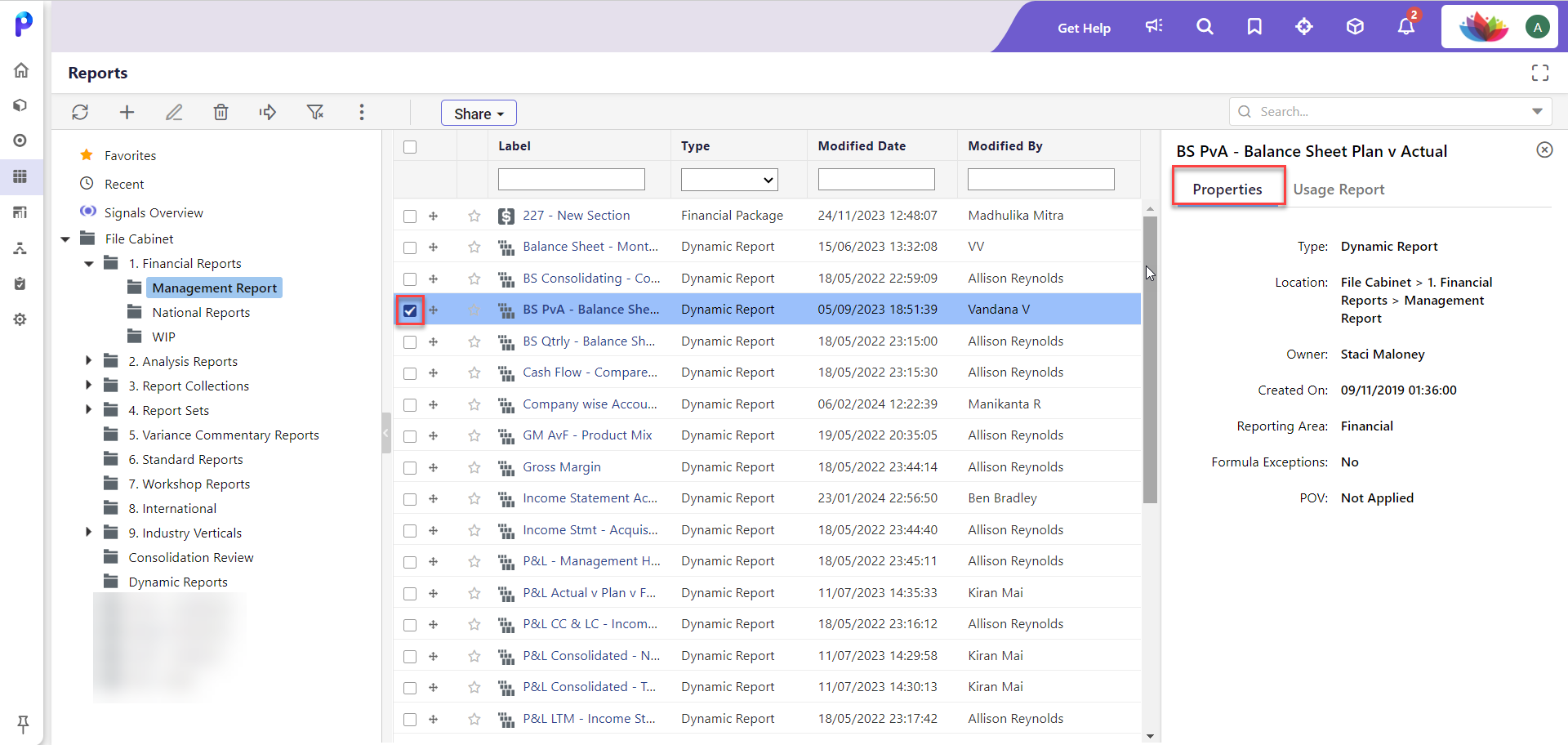
Export as Excel
From the More Options list box, click Export As Excel. A process will be submitted in the cloud. Once the process is completed, a message will display with a link to download to Excel..png)
The Share option is used for managing access and sharing reports.

This menu offers two key functionalities:
Share Access
This functionality allows you to control and manage access permissions for folders and reports within the File Cabinet. You can specify which users or user groups have access, define their level of access, and choose whether child artifacts should inherit these permissions. You can use this feature to control who can view, edit, or manage the reports.
To manage access permissions using Share Access, do the following:
- Click Share > Share Access. The Share Reports window is displayed.
- Select the required folder or report from the drop-down list. By default, the folder or report selected in the File Cabinet page is displayed in the drop-down list.
- Select the Inherit Permissions from the checkbox and select the required folder from which you wish to inherit permissions. Permissions can be inherited only from one of the parent folders in the hierarchy.
- Type the user or user group name that you want to add in the search box.
- Select any of the following access privileges:
- Can Read
- Can Edit
- Full ControlNotes:
- You can provide Can Edit access only to folders.
- An administrator or a user with Full Control access can share a report.
- Select one of the following from the Apply Permissions to Children drop-down list:Note:The Apply Permissions to Children drop-down list is only visible for folders.
- Never: If selected, the artifacts have independent permissions. By default, this option is selected.
- Always: If selected, the source artifact permissions are inherited to existing and newly added artifacts at all levels. The artifact status is displayed as Inherited beside the user or user group name.
For example, if Always is selected for a parent artifact, the children's artifacts will inherit the same permissions as the parent. The image below displays that the Financial Reports (child) folder inherits the same permissions as the File Cabinet (parent) folder.
When the permissions on the source artifact are updated, the same permissions are applied to all its children automatically.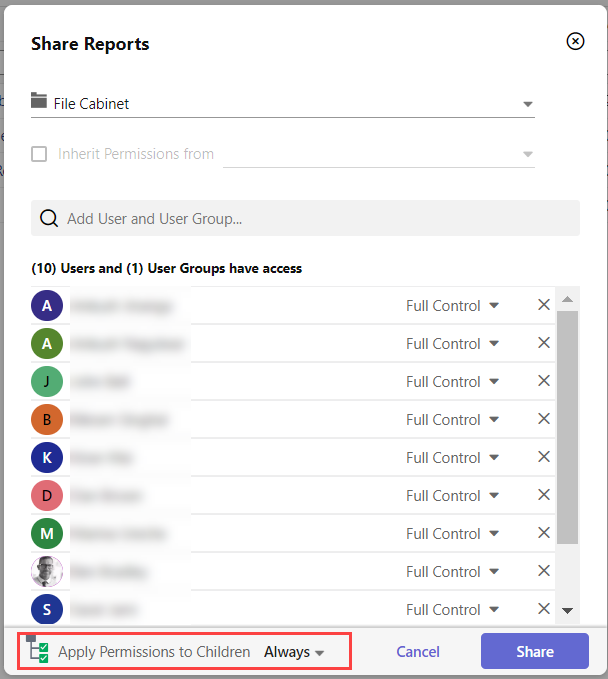
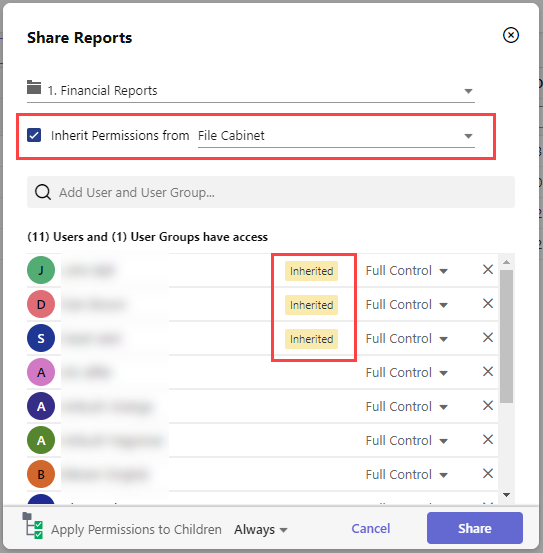 Notes:
Notes:- Overriding or removing permissions in the target artifact does not update them for existing users or user groups.
- Changes to permissions are effective only for users or user groups with the 'Inherited' status or when new users or user groups are added to the source artifact.
- Once: If selected, the artifact permissions are copied only to all the existing children. Any new child added to the artifact will not have the same permissions. Also, if you update permissions on the source artifact, the same permissions are not copied to its children automatically.Note:Permissions are inherited only to those artifacts for which the user has Full control access.
- Click Share.
- You can also share the links using the Share Access option. In the Share Reports screen, click Copy Link. The link will be copied and you can share the link offline through email or messaging.
- The Copy Link option is enabled only when you select the report.
- The users listed within the Share Reports window will be able to access it, depending on their permissions.
Copy Link
This option allows you to copy report links and share them with users. The copied links honor security permissions, ensuring that users can access reports based on their permissions. Users can view reports and, if they have permission to edit, make direct edits through the shared links.
- This option is enabled only when you select the report and then go to the Share menu.
- You can select only one report to use the Copy Link option.
If you are certain that the user you want to share the copied link with has access to the selected report, do the following:
- Select the report you want to share from the File Cabinet.
- Click Share > Copy Link in the menu bar.
.png)
- Share the link offline through email or messaging.
File Cabinet
File Cabinet provides you the ability to store and organize reports, and report artifacts such as Reports, Report Sets, Report Collections, and Documents in a hierarchical folder structure. You can view default folders and sub-folders when you open the File Cabinet page for the first time.
Navigate to the Reports icon from the application home page to access the Reports home page.

Access the File Cabinet from the Reports page as shown below.

To open any artifact in the File Cabinet, there are 2 options:
Click the artifact label link to open the artifact directly.
Select the check box next to the artifact label and then select an option in the toolbar to work with the artifact.
Favorites
The following are some points to remember related to the reports you add in Favorites:
- For a Reporting Administrator user, when the security associated with an artifact (report or folder) is changed, the affected Reporting Administrator user(s) will still have access to the artifact. The artifact will not be removed from the Reporting Administrator’s Favorites.
- For a Reporting user, when the security associated with an artifact (report or folder) is revoked by a Reporting Administrator or Reporting user, the affected user(s) will no longer have access to the artifact even though it will appear in their Favorites.
- No matter if you are a Reporting user or Reporting Administrator user, when permissions to an artifact are copied, the artifact will not be present in Favorites for the target user even if present in Favorites for the source user.
- Favorites functionality does not apply to user groups.
Recent
The Recent tab displays the list of reports recently accessed by you.
Search Reports
Enter criteria to search for specific artifacts or click the gray arrow to expand a search pane (shown below) where you can select specific search criteria.

Best Practices
- We recommend administrators review the usage of artifacts and remove the unused artifacts periodically (at least once in 6 months).
Limitations
- A maximum of 10 reports can be opened simultaneously.
- A maximum of 100 reports are displayed on the File Cabinet Page. If the reports exceed more than 100 then it is displayed on the next page.
- A maximum of 50 reports can be added to the Favorite list.
- A maximum of 50 reports are displayed on the Recent page.
- A maximum of 5MB document is allowed on the File Cabinet page. You can split the file if it exceeds 5MB.

.PNG)
.png)







.png)



.png)